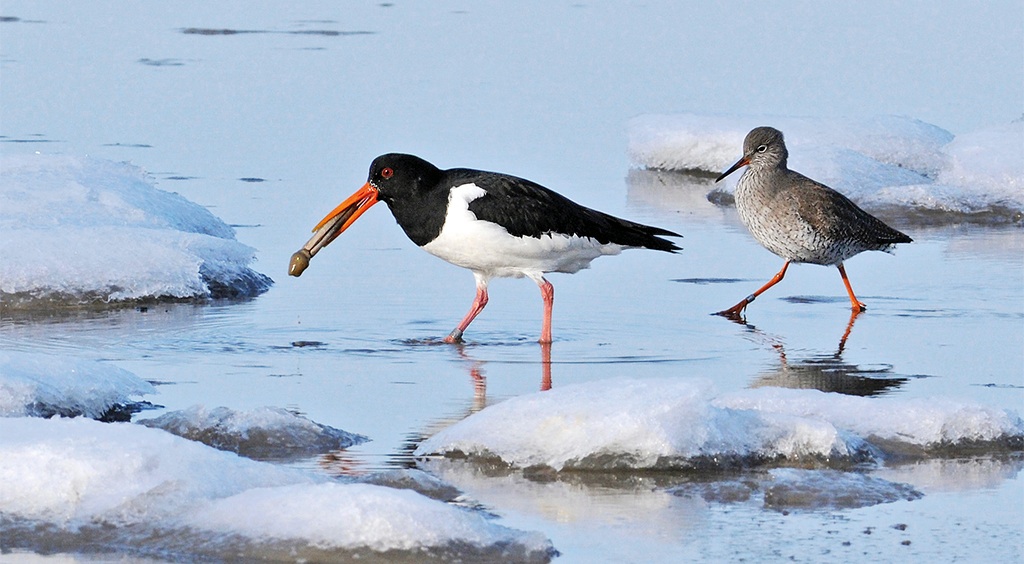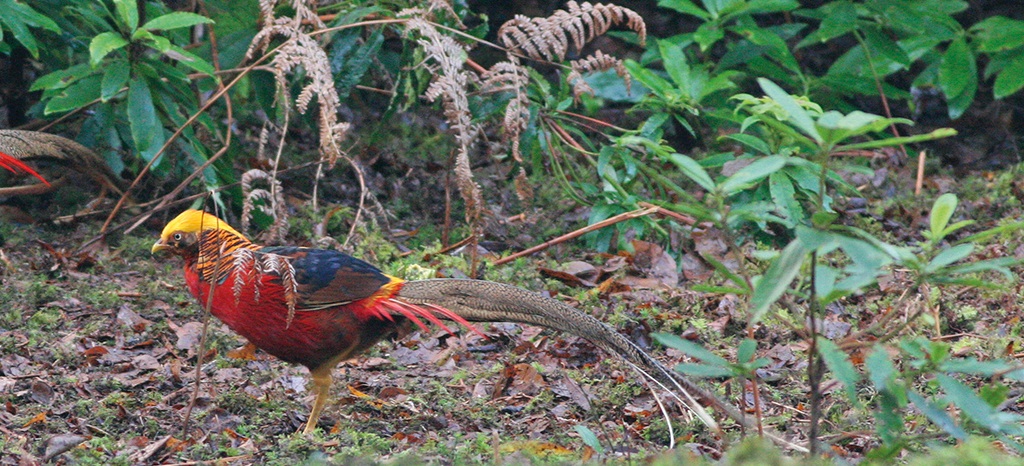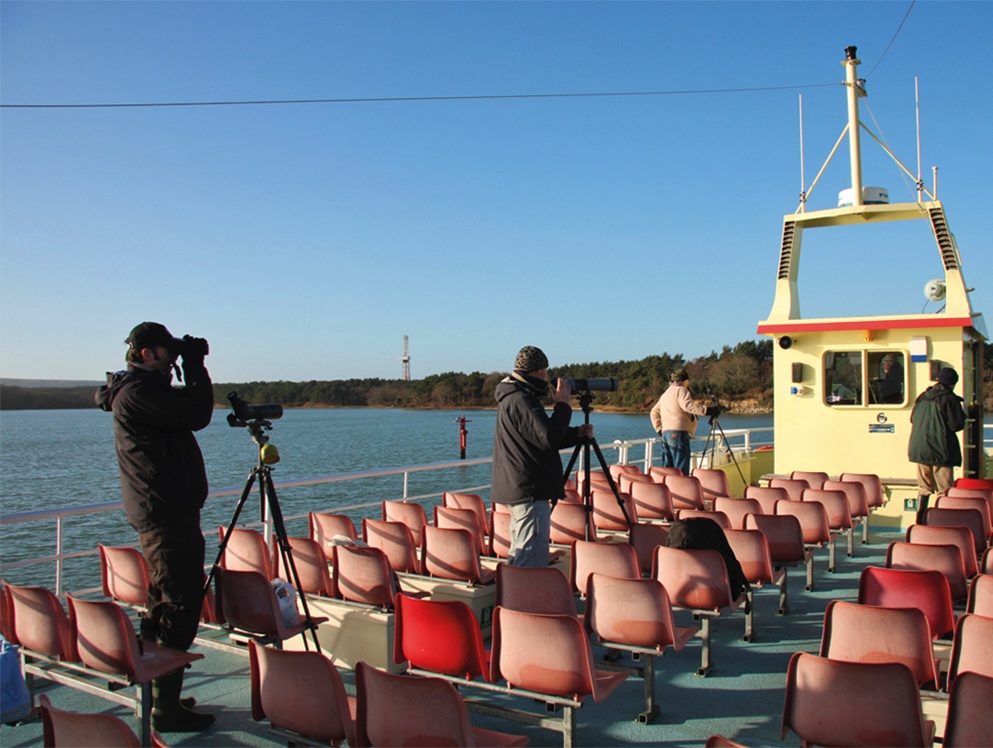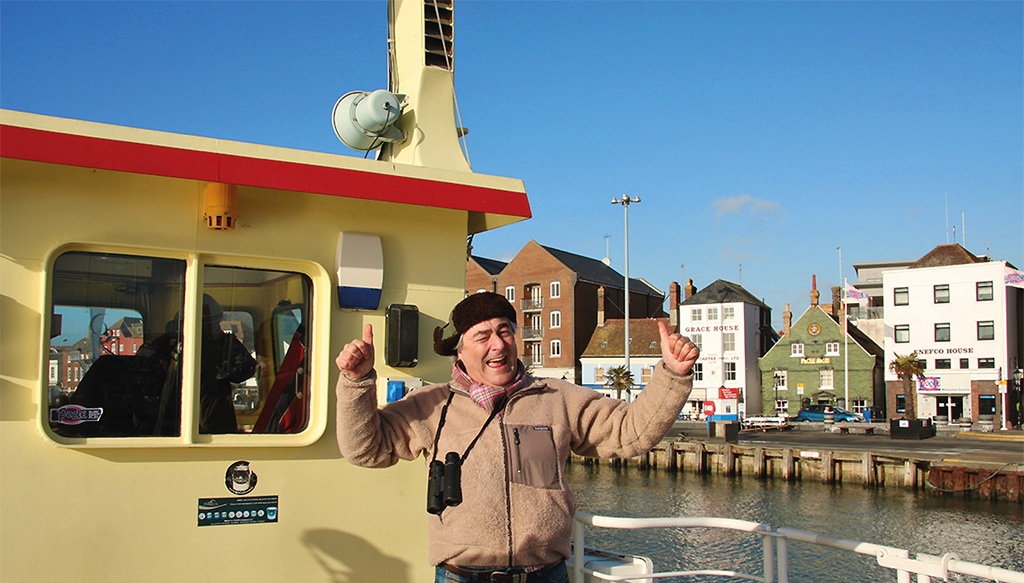Looking out of the window along the clifftop above Burton Bradstock beach in the most western part of Dorset, Billy Bragg could see flocks of birds where normally there were none. He watched spellbound as a mass movement of Lapwings travelled east up Chesil Beach, and they weren’t alone. There was a host of smaller birds too. It was a sign of hard times, a phenomenon of biblical proportions. He phoned fellow musician and birder Simon Emmerson and described what Simon realised were Redwings and Fieldfares. Billy was reminded of a story he had heard while making a documentary about Woody Guthrie. He had visited Pampa near Amarillo, where he interviewed a woman who had witnessed the big dust storm that hit the Texas Panhandle on Black Sunday (14 April 1935). She told him that the first sign was thousands of birds flying fast and low, ahead of the dust cloud.
At 13:00, Simon sent us an email describing what Billy had seen and adding, “I’d get down there myself but we are totally snowed in up here in the hills, with all exits from the village blocked by abandoned cars. Armageddon time!” Fieldfares, Redwings, Skylarks, Lapwings and even the odd Snow Bunting were fleeing east from Devon and Cornwall. Displaced by snowstorms, they flew into the strengthening easterly wind and towards us.
Meanwhile further east, Hamish, also unable to move his car, had walked up to Durlston where he counted a staggering 34,000 Fieldfares moving north-northeast. Steve Smith could see the birds heading north over Swanage. He was getting late for work but managed a five-minute look across Studland Bay, where streams of Fieldfares and Skylarks were battling across the choppy water, into the freezing easterly wind.
On hearing the news, I rushed out onto my platform and was confronted with a whiteout. Every so often a flock of 40 or so Fieldfares materialised, then shot over very close to the roof. I could have reached out and touched them. I couldn’t see if we were enjoying very large numbers because of the blizzard, but just down the road birders that had made it to Mudeford Quay during the afternoon saw 33,000 Fieldfares, 12,000 Redwings and over 30,000 Skylarks.
Shaun got very excited, pointing out that this could be the last cold weather movement we would ever see. He obviously hadn’t had a beer with Ian Alexander lately. As Ian suggested, despite the sub-zero temperatures and frozen pipes locally, globally speaking 2009 was still the fifth warmest year on record, and according to NASA, 2010 tied with 2005 as the warmest. This was despite yet another cold British winter complete with cold weather movements.
To see one of these cold weather movements, you have to react very quickly to fast moving news. Billy saw the birds at the western end of the county in the morning, and most of the movement had cleared Christchurch in the east by 16:00. If you were preoccupied with more mundane tasks like getting home in a snowstorm you missed it.

Eurasian Oystercatcher Haematopus ostralegus and Common Redshank Tringa totanus, Shore Road, Poole, Dorset, 10 January 2010 (Nick Hopper). ‘Oystercatcher and Redshank feeding in snow, both ringed.’
The cold arrived very quickly. One minute John Down was watching a December swallow flying over Wareham, when suddenly we were in the middle of a reassuringly old fashioned British winter. Late December brought surprise snow and trapped Christmas shoppers in their cars. Swine flu disappeared from the headlines, as the arctic temperatures swept across Europe. Copenhagen’s climate conference was suddenly looking rather irrelevant, and an icy Polar Bear that was supposed to melt in Trafalgar Square remained resolutely frozen. By 18 December 2009, most of Britain including Cornwall was covered in snow.
In Poole at first we were the exception. Nick was out and about finding odd birds in odd places, all seeking refuge. One of his emails ended, “This could be the all time classic cold weather movement scenario for Poole Harbour. I can almost feel a whole new chapter coming on!!”
On 23 December, after a work’s Christmas lunch, I was sitting looking out and spotted a Black Redstart tucked up on a roof behind my office. My thoughts went to bird racing. Terry had been emailing us all, asking if we were going to do one, since mid-November. I hadn’t really decided if I was on for a race. Still, a tame Black Redstart could come in handy.
New Year’s Eve was very sedate with a dinner, champagne, lots of birders’ chat and off to bed by 01:00. The next morning I woke to Blackcaps chasing each other off the fat balls, Goldfinches squabbling over the niger feeders, Jays sneaking in to gobble the peanuts, and Bullfinches whistling sweetly from the bushes (CD2-91). I didn’t want to get into a traditional New Year’s Day debate with Mo, so I strategically suggested she had a lie in while I cycled around Holes Bay. We could then meet at the quayside at 11:00 to join the other birders for our traditional New Year’s Day Bird Boat trip around the harbour.
CD2-91: Eurasian Bullfinch Pyrrhula pyrrhula Poole, Dorset, England, 15:32, 2 April 2008. Singing in Mark’s suburban garden on a windy day. Background: European Robin Erithacus rubecula and European Blue Tit Cyanistes caeruleus. 080402.MR.153248.01
We had a lovely boat trip. The weather was perfect, pretty cold but dry and bright. Nick had drunk too much champagne the night before so didn’t make it out of bed. Ewan, Roger, Terry and James Phillips, however, were all there. Together they are our arch rival bird racing team, and they are not regulars on the bird boat. I should explain that by this point we had decided to do a January bird race, but instead of the usual sprint around Dorset, we were limiting ourselves to the confines of Poole Harbour. Not knowing the harbour well, Roger’s team had declined the invitation to compete. I wondered why they had all, seemingly coincidentally, decided that it would be a nice idea to join the bird boat. They weren’t secretly scouting, were they?
As it turned out, they were being even more cunning than that! On the boat, Roger shared soup with Shaun (one of our team members) and innocently asked whether he might feel like a boy’s night out at Prezzo Pizza with James and Terry. The next night Shaun was half way through his pizza when he realised that the conversation was all about the birds in Poole Harbour. There was something going on. “You guys are planning to do the bird race, aren’t you?” There were a few smiles and then they came clean. Terry explained that as they had easily set the county winter day record at 129 in 2008, they were now looking at other records to challenge. James chipped in that if they could have agreed about the Greenshank seen from Evening Hill on Brownsea lagoon (a mile away), it would have been 130. James and Roger then admitted they were looking to secure the double – Dorset and Poole Harbour winter records – so they were giving Dorset a rest to concentrate on beating the Poole Harbour record held by our team and then standing at 119. They were the most competitive team Shaun had ever met, and absolutely revelled in their victories. When he looked surprised, Roger smiled and repeated that they really did intend to take the Poole record.
The race was to take place on 9 January, and Shaun knew he hadn’t really got the team together, had no strategy and had done no scouting. When he got home, he sent Hamish, Nick and me an email. “Are we up to the challenge? Roger’s team wants to break our record. Are we all up for taking them on? Look forward to hearing ideas!”
Nick answered first: “Consider the gauntlet thrown down! No way are those guys beating us on our own patch! I will be out today.” Hamish also replied, “Let’s do it!”
A great tradition, bird races are often sponsored and there’s a prize cup named after Hamish’s marvellous birding dog Douglas (since deceased) for the team that sees the most species in Dorset in a January day. There are normally between six and eight teams in a bird race, with varying levels of experience.
I was now really up for competing, and suggested that we hired the bird boat. Nick liked the idea but Shaun thought it could waste a lot of time. Hamish agreed. He wasn’t sure about the added value of a boat trip. “Perhaps I’ve still got too vivid a memory of the last time we took a boat to Brownsea in a bird race!”
I have to admit, most of my efforts to get bird race teams around the harbour have been a disaster, and most have involved Hamish. The two of us have been bird racing around Dorset since August 1980. In that first year, our effort to see 100 species in the county ended with 91, but after a few more goes we eventually managed to set a record Dorset day of 123 on 5 May 1984. On that day I really thought I had it sorted. Phil Greaves, a fireman, had contacts in the coastguard. He persuaded them to pick us up in an open inflatable powered by two huge outboards. The team at the time was Tasie Russell, Dick Burt, Hamish and me. Phil was there to pick us up from the pier at South Haven to go to Brownsea, then take us right across to Holton Heath. We reached Brownsea OK, but I hadn’t realised that on a windy day buckets and buckets of freezing cold seawater will pour over you and your optics at high speed.
I vividly remember trying to be as insignificant as possible to avoid both the freezing deluge and Hamish’s gaze. As we tried to reach the Holton shore, Phil, wanting in some way to make amends, jumped deep in the cloying mud and tried to manoeuvre the boat so that we could step ashore. It was impossible, so we all had to do a bit of mud wrestling.
I had a borrowed Range Rover waiting. We changed what clothes we could but it was miserable. Nothing was said and we continued the race. Eight hours later we all stood shivering in the darkness at Martin Down in the north of the county hoping for a Stone-curlew to call. In the darkness I confessed, “I’m really cold”. “Good,” was Hamish’s quiet reply out of the dark. So for this latest bird race I was thinking that the expensive yet sedate big old yellow two-deck bird boat would be more appropriate.
Snow and ice were now everywhere in Britain, and this was creating further cold weather movements. I suggested to the others that the team that kept warm and healthy would gain the advantage. Nick admitted he already had a touch of ‘man flu’ so would stay indoors for a couple of days. We discussed a strategy that used our local knowledge and avoided being out in potentially icy conditions too early in the morning or worse, stuck in ditches. During the last autumn race Nick had reversed into a ditch at Arne at 04:00. Both front wheels were off the ground and all looked lost when Kevin happened to come by. He kindly drove Nick to Sandford where he was able to blag a piece of rope off a guy in a van. Only with Kevin’s car pulling and three people pushing did he and Magnus manage to get back in the race. Later Kevin got a lot of grief from fellow racers for that act of kindness, as Nick and Magnus went on to win the bird race, setting a new autumn record.
If we could keep calm and warm, I thought we could trust Roger’s overenthusiasm to see him come unstuck. We secretly started scouting like fury, but there wasn’t enough time. Langton Steve Smith, seeing that the schools were closed and there were warnings to wildfowlers, suggested a postponement. Not really knowing what it would mean for our opponents, we suggested rescheduling for the following Sunday. It certainly helped us, as it gave us more time to catch up on scouting and, as it turned out, put Roger’s carefully laid plans into turmoil.
The first thing we did was re-book the big yellow boat. We hoped for a bit of ‘Shock and Awe’. Hopefully, seeing the four of us perched on top of it as it manoeuvred around the harbour would be such a spectacular display of force that it would paralyse Roger and his team, and they would give up and go home.
Our scouting started in earnest, and potentially the most elusive bird would be the Snow Bunting that had taken up residence on the customs dock opposite the quay by the bonded warehouse (the mysterious ‘workshop M’). It was legally off-limits, and remained that way despite our pleading with the authorities. I tried with my scope from Poole Quay, and from the balcony up the steps by the Italian Gossip restaurant.
Rob, the skipper of the boat we were to hire, happened to be moored at the quay for some welding work. He could see me lugging my scope up the steps to sit next to the sea music sculpture, trying to get an angle on the dock, desperate to see this Snow Bunting. Eventually he took pity on me and promised that when the welding was done, he would take me across to the dock. We tried this, but no matter what, I couldn’t see it. My lucky Black Redstart was there though, with a regular Kingfisher hidden amongst the rocks, out of sight for anyone on the quay.
If you want to win a bird race, you can’t wait until dawn to get started. Roger, ever the competitor, would have roused his team and got them going by 04:30. The sun was unlikely to join any of us until 08:00 most years, and on a rainy morning, first light could be even later. Low tide was to be 11:12 at the Quay, and wouldn’t last for too long so we also needed to think about that.
As we had hoped, Terry later told us his team did not set out with great confidence, because the tides and timing for the previous weekend had been ideal. “This weekend, however, things were not going to be straightforward, and we had lost our lift to Brownsea. Permissions had been granted for a Saturday landing, and access to the island was not possible on the Sunday.”
Their start didn’t go well. They missed the Greylags in the dark at Poole Park and didn’t connect with the Barn Owls at Middlebere. At least they had a Tawny Owl, which was a start and a Woodcock, which should have been a help for later in the day. They then hit ‘the Bridges of Branksome’, ticking off Gannet and Red-throated Diver. A half decent seawatch for this site was quickly followed by Goosander off of Evening Hill.
They dipped on the roosting Purple Sandpipers and Sanderlings on the Sandbanks Groynes, but once they got to Studland things improved, the highlights being both Slavonian and Black-necked Grebes, Great Northern Diver, Long-tailed Duck, Common Eider, Common Scoter, Red-crested Pochard, Linnet, Yellowhammer, Dartford Warbler and of course the all-important Ring-necked Parakeets.
Their list grew in leaps and bounds at what was probably their best stop of the day: Wytch Causeway. As Terry recounted, “This started with a Hen Harrier on the deck, being mobbed by a Carrion Crow. It soon took flight and quartered across the marsh in such brilliant crisp winter sunshine. What a buzz! These are the moments when a bird race becomes a hinderance, as it becomes very hard to leave certain sites and birds behind! Still, just being out and enjoying such magical birds in these precious places is always a delight.” Further gains for their team there included a Spoonbill roosting on the spit, a Green Sandpiper on the marsh, along with a Water Pipit and a host of the more usual species scattered across the distant water and saltmarsh.
Being so far round the harbour, they had missed seeing us on the bird boat. Damn! We had arranged for Kevin to join us to take some photos, knowing he would enjoy it, and most importantly as an impartial witness to counter any suggestions of stringing.
From our boat, we checked out the rocks at the harbour mouth where eight Purple Sandpipers and 13 Sanderlings were roosting, then headed down the channel towards Goathorn, picking up Long-tailed Duck, Slavonian Grebe and a Scaup. I have to be honest. Only one bird boat in 10 sees Golden Pheasant, so we just hung off Furzey Island to try our luck. Shaun got impatient and I had to ignore the general “How long do you intend keeping us here?” mutterings, until there, in all their glory, four Golden Pheasants started running around the edge of the lawn. We then took the boat slowly past Brownsea lagoon, picking up Spoonbill, Spotted Redshank and Red Knot.
Sailing our way gradually towards Poole Quay and, we hoped, our trump card, we took in Salterns Marina, where we saw another Slavonian Grebe, and Liliput where we ticked a nice male Goosander. Kevin takes up the story: “As we headed towards Poole Quay, two Great Northern Divers swam alongside the boat… I then casually mentioned that the Snow Bunting apparently sometimes sat up on the fencing, at which point Shaun said ‘what’s that bird on the fence?’ Sure enough it was the Snow Bunting, which lingered just long enough for me to get it in the scope before dropping down behind some metal girders. That was the last we saw of it. Then Hamish picked up the serendipitous Black Redstart flitting amongst the rocks.”
Roger’s team had also been busy, clocking up Raven and Grey Wagtail before Arne produced the key woodland species. At this point, finally, the overenthusiasm that I was praying for kicked in. Or as Terry put it, “Well… then we took a bit of a plunge as we tested the semisubmersible capabilities of my car! We arrived at East Holme to find the ford crossing somewhat full. There we sat and pondered, whilst Roger rubbed his hands together and said, ‘it’s time to get my own back.’ He was referring to a race about 8 years ago when he drove down a flooded road, during which a large quantity of water soon joined us in the car!”

Golden Pheasant Chrysolophus pictus, male, Rose Cottage, Brownsea Island, Dorset, 1 December 2008 (Kevin Lane)
“James assured me that all would be fine as a car had come from the other direction. I still wasn’t going to go for it, but then a moment of madness saw a bow wave over the bonnet and half way up the windscreen! At this point I said to James, ‘What made you think that other car had come through? It could have just been sensible and turned around?’ He replied with a slight giggle in his voice, ‘Oh yes, I guess it could have done.’
We then spent the next 10 minutes or more trying to get the car going, sending huge plumes of smoke through the village, which Roger referred to as something out of Harry Potter.”
“Anyhow, all this was to be worth it, wasn’t it…? No such luck. We added not a single bird to the list. We did have another Goosander, which on any other race would have made it well worthwhile. Still, nice record nonetheless. Stupidly, we only looked down the Frome valley and not up, as this was where the Bewick’s were!”
Things didn’t get much better for Roger’s team, and it took over an hour before they added another species, a Firecrest at Creekmoor. They could only manage another four species in the next hour and a half. Thankfully for Terry and Ewan, their home patch, Hatch Pond, gave them two of those, which were Chiffchaff and… stunning views of one of the Bitterns sitting out in the open. Holes Bay gave up Common Sandpiper in seconds, but the Red Knot that they had seen on both the two previous days was missing.
Swineham got them going again with great views of Marsh Harrier and Scaup, along with some pinging Bearded Reedlings and a calling Cetti’s Warbler. They shot off to Middlebere in the hope of a Barn Owl. No luck, so they left for a second shot at the Greylags in Poole Park, passing us on the way out. Within minutes we were watching the Barn Owl flying around the buildings!

Shaun, Nick, Mark and Hamish on bird boat, Brand’s Bay, Dorset, 17 January 2010 (Kevin Lane). ‘On the bird boat, hoping for a bit of Shock and Awe.’
The finish line was my home, and all the teams had to be there by 18:30, with a bird deducted for every minute late. The kitchen bustled, but no one was divulging how many species they had seen.
We had recently come up with a new way of revealing the scores. Everybody puts their hands up at the start, as Shaun starts shouting out ascending numbers into the packed room. As your score comes up, you put your hands down. This ultimately leaves the winning team with their hands in the air. He started. “90… 91… 92…” and by the time he got to 110 there were only two teams left: Roger’s and ours.
Shaun continued, “111… 112… 113… 114…” All hands remained resolutely aloft. “115… 116…” Finally all the hands in Roger’s teams went down. We had beaten them!
But wait for it. “117… 118… 119… 120…” Now the old record had gone. “121… 122… 123…” and finally our hands went down. One hundred and twenty three! The look on Roger’s face was of utter disbelief. There is an old Chinese proverb that says, “Fortune doesn’t change a man. It only unmasks him.” Whatever Roger’s team had been full of in previous years now flowed across the room and filled us.
The weather had been perfect, helping us to achieve a great score. All in all, it had been one of our best birding days in the harbour ever with highlights including Snow Bunting, Black Redstart, Golden Pheasant, Goosander, Firecrest, Long-tailed Duck, Red-crested Pochard, Red-throated Diver, Barn Owl, Lesser Redpoll, Hen and Marsh Harriers, Chiffchaff, Bittern and Bewick’s Swan. Despite reaching 123, we had missed two birds carefully scouted at Wytch Causeway: Green Sandpiper and Water Pipit. We remembered seeing Roger’s team leaving just as we arrived. At the time we joked that they had probably scared them off.

Jubilant Mark, bird boat at Poole Quay, Poole Harbour, Dorset, 17 January 2010 (Kevin Lane). ‘Next year.’
Homemade soup was served and the conversations flowed back and forth. Terry was asking whether at 123 this record would even be worth chasing in the future. I could hear him say, “Would have been great though, wouldn’t it, if it had been on the Saturday and we’d passed each other, neither team knowing that the other was involving a boat! Ah well, records are there for breaking.”
As everyone was leaving, Roger smiled and said, “See you next year.”